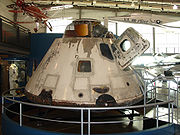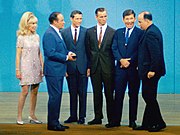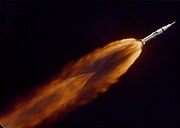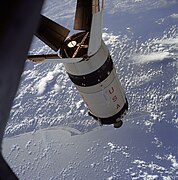Template:Infobox spaceflight
Apollo 7 was a 1968 human spaceflight mission carried out by the United States of America. It was the first mission in the United States' Apollo program to carry a crew into space. It was also the first U.S. spaceflight to carry astronauts since the flight of Gemini XII in November 1966. The AS-204 mission, also known as "Apollo 1", was intended to be the first manned flight of the Apollo program, scheduled to launch in February 1967. However, a fire in the cabin during a January 1967 test killed the crew. Manned flights were then suspended for 21 months, while the cause of the accident was investigated, and improvements were made to the spacecraft and safety procedures. Apollo 7 essentially fulfilled Apollo 1's mission.
The Apollo 7 crew was commanded by Walter M. Schirra, with Command Module Pilot Donn F. Eisele, and Lunar Module Pilot R. Walter Cunningham. Their mission was Apollo's 'C' mission, an 11-day Earth-orbital test flight to check out the redesigned Block II Apollo Command/Service Module (CSM) with a crew on board. It was the first launch of a Saturn IB vehicle to put a crew into space, the first three-person American space mission, and the first live TV broadcast from an American spacecraft. It was successfully launched on October 11, 1968, from what was then known as Cape Kennedy Air Force Station, Florida. Despite tension between the crew and ground controllers, the mission was a complete technical success, giving NASA the confidence to launch Apollo 8 around the Moon two months later. However, the flight would prove to be the final space flight for all of its three crew members when it splashed down in the Atlantic Ocean on October 22, 1968. It was also the final manned launch from Cape Kennedy.
Crew[]
| Position | Astronaut | |
|---|---|---|
| Commander | Walter M. Schirra Third and last spaceflight | |
| Command Module Pilot | Donn F. Eisele Only spaceflight | |
| Lunar Module Pilot | R. Walter Cunningham Only spaceflight | |
| Lunar Module Pilot was the official title used for the third pilot position in Block II missions, regardless of whether the LM spacecraft was present or not. | ||
Backup crew[]
| Position | Astronaut | |
|---|---|---|
| Commander | Thomas P. Stafford | |
| Command Module Pilot | John W. Young | |
| Lunar Module Pilot | Eugene A. Cernan | |
| The backup crew became the prime crew on Apollo 10. | ||
Support crew[]
- Ronald E. Evans
- William R. Pogue
- John L. Swigert
Background[]

Apollo 7's liftoff
Schirra, Eisele, and Cunningham were first named as an Apollo crew on September 29, 1966. They were to fly a second Earth orbital test of the original Block I Command/Service module (not designed to dock with the Apollo Lunar Module for lunar flight) after Apollo 1, the first manned flight, to be made by Virgil "Gus" Grissom, Edward H. White, and Roger Chaffee. In December 1966, the second mission was deemed redundant and canceled, and Schirra's crew were reassigned as Grissom's backup.
Plans for the first manned Apollo flights were completely disrupted by the January 27, 1967 cabin fire which killed Grissom, White, and Chaffee. Schirra, Eisele, and Cunningham were later named as prime crew for the first manned flight, which would now use the Block II spacecraft designed for the lunar missions. The Command Module (CM) and astronauts' spacesuits had been extensively redesigned, to reduce and eliminate the chance of a repeat of the accident which killed the first crew. Schirra thus became the only astronaut to fly Mercury, Gemini and Apollo missions.[1] His crew would test the life support, propulsion, guidance and control systems during this "open-ended" mission (meaning it would be extended as it passed each test). The duration was limited to 11 days, reduced from the original 14-day limit for Apollo 1.[2] Since it flew in low Earth orbit and did not include the Lunar Module (LM), Apollo 7 was launched with the Saturn IB booster rather than the much larger and more powerful Saturn V.[3]
Throughout the Mercury and Gemini programs, McDonnell Aircraft engineer Guenter Wendt had been leader of the spacecraft launch pad teams, with ultimate responsibility for condition of the spacecraft at launch. He earned the astronauts' respect and admiration, including Schirra's.[4] However, the spacecraft contractor had changed from McDonnell (Mercury & Gemini) to North American Rockwell (Apollo), so Wendt was not the pad leader for Apollo 1.[5]
So adamant was Schirra in his desire to have Wendt back as Pad Leader for his Apollo flight, that he got his boss Deke Slayton to persuade North American management to hire Wendt away from McDonnell, and Schirra personally lobbied North American's launch operations manager to change Wendt's shift from midnight to day so he could be pad leader for Apollo 7. Wendt remained as Pad Leader for the entire Apollo program.[5]
Mission highlights[]
Wendt's face was the last they saw before the hatch was sealed, and immediately after liftoff Eisele said with a mock German accent into his radio, "I vonder vere Guenter Vendt?"[5]
On-orbit operations[]

Close-up of the S-IVB stage during rendezvous maneuvers. Note the docking target inside the spacecraft adapter, and how the right-hand panel is not fully opened to the same angle as the others
The first manned American space flight in 22 months lifted from LC-34 at 10:05 AM local time on Friday, October 22, 1968. Liftoff proceeded flawlessly; the Saturn IB performed well on its first manned launch and there were no significant anomalies during the boost phase. The astronauts described it as very smooth riding compared to the rough, bumpy Titan II used to launch the Gemini spacecraft.
Following orbital injection and separation from the S-IVB, the crew turned the CSM around using its Reaction Control System thrusters, and Eisele practiced a simulated Lunar Module rendezvous and docking, using a visual reference target mounted inside the spacecraft adapter in the same radial position it occupied on the LM. One of the adapter panels on the S-IVB failed to completely deploy to its 45 degree open position, reminding CAPCOM Tom Stafford of his "angry alligator" experience on Gemini 9A, when docking was prevented by mis-deployed adapter panels. Had this been an actual lunar mission, the astronauts might have found the process of LM extraction from the adapter more difficult, risking possible damage. This reinforced the decision to add a system to completely separate and jettison the panels on all subsequent Apollo-Saturn V flights.[6]
The Apollo hardware and all mission operations worked without any significant problems, and the Service Propulsion System (SPS), the all-important engine that would place Apollo into and out of lunar orbit, made eight firings, performing within 1% of the engine acceptance test thrust and specific impulse values. As the Saturn IB itself had performed very smoothly during launch, the astronauts were unprepared for the sudden violent jolt they received upon first activating the SPS, leading to Schirra yelling "Yabbadabbadoo!" in reference to The Flintstones cartoon. Don Eisele called it "a real boot in the rear."[7]
An assortment of minor hardware problems occurred over the flight; these included the drinking water hose trigger sticking during the final two days, a momentary undervolt of the main AC buses caused by the automatic cryo fan switch in the service module LOX and LH2 tanks, and a loss of telemetry due to a malfunctioning electrical commutator following SM jettison at the end of the mission, meaning that the final 15 minutes of data transmission were lost. Aside from the last event, which remained a mystery despite postflight testing of the commutator, all of the problems on Apollo 7 were quickly resolved and some of them also involved equipment or procedures that would not be used on subsequent missions.
Apollo promised the best food preparation yet seen on a manned spacecraft. For the first time, astronauts had both hot and cold water to prepare meals with (the food came in freeze-dried vacuum packs that would be injected with water or else eaten dry followed by a sip of water) and Wally Schirra, who had had only toothpaste-like tubes for food on his Mercury flight, described the food as "Still does not match home cooking, but it comes a lot closer than space food used to." Thirty-three meals were provided for the three crewmen, allowing them three meals a day for each of the 11 days in space. Even so, the astronauts complained that there was more food than they could eat and that most of it was too sweet, although the menus had been prepared based on their personal preferences.
Early fears that the movement of the astronauts inside the CM would make it hard for the spacecraft's attitude control system to stabilize it proved unfounded, and they reported that motion was "incredibly easy" with no gravity to work against. As sleeping in the fetal position was cramping and painful, an exercise device called the Exer-Genie was provided.[6]
Another mission goal was the first live television broadcast from an American spacecraft (Gordon Cooper had transmitted slow scan television pictures from Faith 7 in 1963, which were never broadcast).[8] It was initially scheduled for midday on day two, but Schirra was concerned with the broadcast interfering with the rendezvous test.[9]
"Mutiny" in space[]
Even though Apollo's larger cabin was more comfortable than Gemini's, 11 days in orbit took its toll on the astronauts. Tension with Schirra began with the launch decision, when flight managers decided to launch with a less than ideal abort option for the early part of the ascent. Once in orbit, the spacious cabin may have induced some crew motion sickness, which had not been an issue in the earlier, smaller spacecraft. The crew were unhappy with their food selections, especially the high energy sweets. They also found the waste collection system cumbersome (requiring 30 minutes to use) and smelly. But the worst problem occurred when Schirra developed a severe head cold. As a result, he became irritable with requests from Mission Control and all three astronauts began "talking back" to the CAPCOM. An early example was this exchange after Mission Control requested that a TV camera be turned on in the spacecraft:

Walter Schirra looks out the rendezvous window in front of the commander's station on the ninth day of the mission
SCHIRRA: You've added two burns to this flight schedule, and you've added a urine water dump; and we have a new vehicle up here, and I can tell you at this point TV will be delayed without any further discussion until after the rendezvous.
CAPCOM (Jack Swigert): Roger. Copy.
SCHIRRA: Roger.
CAPCOM 1 (Deke Slayton): Apollo 7, this is CAPCOM number 1.
SCHIRRA: Roger.
CAPCOM 1: All we've agreed to do on this is flip it.
SCHIRRA: ... with two commanders, Apollo 7
CAPCOM 1: All we have agreed to on this particular pass is to flip the switch on. No other activity is associated with TV; I think we are still obligated to do that.
SCHIRRA: We do not have the equipment out; we have not had an opportunity to follow setting; we have not eaten at this point. At this point, I have a cold. I refuse to foul up our time lines this way.[10]
A further source of tension between Mission Control and the crew was that Schirra repeatedly expressed the view that the reentry should be conducted with their helmets off, contrary to previous Project Mercury and Gemini experience. They perceived a risk that their eardrums might burst due to the sinus pressure from their colds, and they wanted to be able to pinch their noses and blow to equalize the pressure as it increased during reentry. This would have been impossible wearing the helmets, as the new Apollo helmets were a continuous "fishbowl" type without a moveable visor, unlike previous helmets. However, on repeated occasions over the course of the mission, Schirra was instructed that the helmets should be worn for safety reasons. In the final exchange on the subject, Mission Control made it clear to Schirra that he would be expected to account for flouting instructions:
CAPCOM Number 1 (Deke Slayton): Okay. I think you ought to clearly understand there is absolutely no experience at all with landing without the helmet on.
SCHIRRA: And there no experience with the helmet either on that one.
CAPCOM: That one we've got a lot of experience with, yes.
SCHIRRA: If we had an open visor, I might go along with that.
CAPCOM: Okay. I guess you better be prepared to discuss in some detail when we land why we haven't got them on. I think you're too late now to do much about it.
SCHIRRA: That's affirmative. I don't think anybody down there has worn the helmets as much as we have.
CAPCOM: Yes.
SCHIRRA: We tried them on this morning.
CAPCOM: Understand that. The only thing we're concerned about is the landing. We couldn't care less about the reentry. But it's your neck, and I hope you don't break it.
SCHIRRA: Thanks, babe.
CAPCOM: Over and out.[11]
Exchanges such as this led to Eisele and Cunningham being rejected for future missions (Schirra had already announced his impending retirement from NASA).[6]
Reentry and post-flight evaluation[]
The splashdown point was Template:Coord, 200 nautical miles (Template:Convert/round km) SSW of Bermuda and 7 nmi (Template:Convert/round km) north of the recovery ship USS Essex.[6]
Despite the difficulties between the crew and Mission Control, the mission successfully met its objectives to verify the Apollo Command and Service Modules' flight worthiness, allowing Apollo 8's flight to the Moon to proceed just two months later.[12] Apollo 7 was Project Apollo's only human spaceflight mission to launch from Cape Kennedy Air Force Station's Launch Complex 34.[13] All subsequent Apollo and Skylab spacecraft flights (including Apollo–Soyuz) were launched from Launch Complex 39 at the nearby Kennedy Space Center.[3] Launch Complex 34 was declared redundant and decommissioned in 1969, making Apollo 7 the last human spaceflight mission to launch from the Cape Air Force Station in the 20th century.[3] As of 2015, Cunningham is the only surviving member of the crew. Eisele died in 1987 and Schirra in 2007.[1][12]
Mission insignia[]

Apollo 7 Flown Robbins medallion
The insignia for the flight shows a Command and Service module with its SPS engine firing, the trail from that fire encircling a globe and extending past the edges of the patch symbolizing the Earth-orbital nature of the mission. The Roman numeral VII appears in the South Pacific Ocean and the crew's names appear on a wide black arc at the bottom. The patch was designed by Allen Stevens of Rockwell International.[14]
Crew honors[]
After the mission, NASA awarded Schirra, Eisele, and Cunningham its Exceptional Service Medal in recognition of their success. On November 2, 1968, President Lyndon Johnson held a ceremony at the LBJ Ranch in Johnson City, Texas, to present the astronauts with the medals. He also presented NASA's highest honor, the Distinguished Service Medal, to recently retired NASA administrator James E. Webb, for his "outstanding leadership of America's space program" since the beginning of Apollo.[15]
Schirra, Eisele, and Cunningham were the only crew, of all the Apollo, Skylab, and Apollo-Soyuz Test Project missions, who had not been awarded the Distinguished Service Medal immediately following their missions (though Schirra had received the medal twice before, for his Mercury and Gemini missions). Therefore, NASA administrator Michael D. Griffin decided to belatedly award the medals to the crew in October 2008, "[f]or exemplary performance in meeting all the Apollo 7 mission objectives and more on the first manned Apollo mission, paving the way for the first flight to the Moon on Apollo 8 and the first manned lunar landing on Apollo 11." Only Cunningham was still alive at the time; Eisele's widow accepted his medal, and Apollo 8 crew member Bill Anders accepted Schirra's. Other Apollo astronauts, including Neil Armstrong, Buzz Aldrin, and Alan Bean, were present at the award ceremony. Former Flight Director Christopher C. Kraft, Jr., who had been in conflict with the crew during the mission, sent a conciliatory video message of congratulations, saying: "We gave you a hard time once but you certainly survived that and have done extremely well since...I am frankly, very proud to call you a friend."[12]
Spacecraft location[]

The Apollo 7 Command Module as exhibited at The Frontiers of Flight Museum
In January 1969, the Apollo 7 Command Module was displayed on a NASA float in the inauguration parade of President Richard M. Nixon. For nearly 30 years the Command Module was on loan (renewable every two years) to the National Museum of Science and Technology, in Ottawa, Ontario, along with the space suit worn by Wally Schirra. In November 2003, the Smithsonian Institution in Washington, D.C., requested them back for display at their new annex at the Steven F. Udvar-Hazy Center. Currently, the Apollo 7 CM is on loan to the Frontiers of Flight Museum located next to Love Field in Dallas, Texas.
Depiction in media[]

Barbara Eden, Bob Hope, Eisele, Cunningham, Schirra, and "voice of Mission Control" Paul Haney, on The Bob Hope Show
On November 6, 1968, comedian Bob Hope broadcast one of his variety television specials from NASA's Manned Spacecraft Center in Houston to honor the Apollo 7 crew. Barbara Eden, star of the popular comedy series I Dream of Jeannie, which featured two fictional astronauts among its regular characters, appeared with Schirra, Eisele and Cunningham.
Schirra parlayed the head cold he contracted during Apollo 7 into a television advertising contract as a spokesman for Actifed, an over the counter version of the medicine he took in space.[16]
The Apollo 7 mission is dramatized in the 1998 miniseries From the Earth to the Moon episode "We Have Cleared the Tower", with Mark Harmon as Schirra, John Mese as Eisele, Fredric Lehne as Cunningham, and Max Wright as Wendt.
A documentary, The Log of Apollo 7, has been restored from 16 mm film and posted online.[17]
Gallery[]
See also[]
- List of Apollo missions
- Splashdown (spacecraft landing)
References[]
This article incorporates http://www.jsc.nasa.gov/policies.html#Guidelines public domain material from websites or documents of the National Aeronautics and Space Administration.
- ↑ 1.0 1.1 Template:Cite news
- ↑ Template:Cite news
- ↑ 3.0 3.1 3.2 Template:Cite journal
- ↑ Pearlman, Robert Z. (May 3, 2010). "Guenter Wendt, 86, 'Pad Leader' for NASA's moon missions, dies". Robert Pearlman. http://www.collectspace.com/news/news-050310a.html. Retrieved June 12, 2014.
- ↑ 5.0 5.1 5.2 Farmer & Hamblin 1970, pp. 51–54
- ↑ 6.0 6.1 6.2 6.3 Wade, Mark. "Apollo 7". http://www.astronautix.com/flights/apollo7.htm. Retrieved October 24, 2008.
- ↑ "Apollo 7 Mission Report" (PDF). NASA. December 1, 1968. pp. 5–158. http://ntrs.nasa.gov/archive/nasa/casi.ntrs.nasa.gov/19760072144_1976072144.pdf.
- ↑ Steven-Boniecki 2010, pp. 55–58
- ↑ Template:Cite news
- ↑ "Apollo 7 Air-to-Ground Voice Transcriptions" (PDF). NASA. pp. 117–118. http://www.jsc.nasa.gov/history/mission_trans/AS07_TEC.PDF. Retrieved October 24, 2008.
- ↑ "Apollo 7 Air-to-Ground Voice Transcriptions" (PDF). NASA. p. 1170. http://www.jsc.nasa.gov/history/mission_trans/AS07_TEC.PDF. Retrieved October 24, 2008.
- ↑ 12.0 12.1 12.2 Pearlman, Robert Z. (October 20, 2008). "First Apollo flight crew last to be honored". Robert Pearlman. http://www.collectspace.com/news/news-102008a.html. Retrieved June 12, 2014.
- ↑ The Air Force Station was originally named Cape Canaveral, but the name was changed to Cape Kennedy by President Lyndon B. Johnson shortly after President John F. Kennedy's death in November 1963. The name Canaveral was reverted in 1973.
- ↑ Hengeveld, Ed (May 20, 2008). "The man behind the Moon mission patches". Robert Pearlman. http://www.collectspace.com/news/news-052008a.html. Retrieved July 6, 2013. "A version of this article was published concurrently in the British Interplanetary Society's Spaceflight magazine." (June 2008; pp. 220–225).
- ↑ Speech given by President Lyndon B. Johnson addressed to the astronauts of the Apollo 7 flight. See site for the full account of the recorded speech. Retrieved December 8, 2014. http://www.presidency.ucsb.edu/ws/?pid=29220
- ↑ "40th Anniversary of Mercury 7: Walter Marty Schirra, Jr.". nasa.gov. http://history.nasa.gov/40thmerc7/schirra.htm.
- ↑ The Log of Apollo 7 on YouTube
Bibliography[]
- Template:Cite book
- Template:Cite book
Further reading[]
- Template:Cite book
- Template:Cite book
External links[]
| File:Commons-Logo.svg | Wikimedia Commons has media related to Category:Apollo 7. |
- NSSDC Master Catalog at NASA
- Apollo 7 Press Kit (PDF) NASA, Release No. 68-168K, October 6, 1968
- The Apollo Spacecraft: A Chronology NASA, NASA SP-4009
- "Apollo Program Summary Report" (PDF), NASA, JSC-09423, April 1975
Multimedia
- The Flight of Apollo 7 NASA documentary film at the Internet Archive
| |||||||||||||||||||||||||||||||||||||||||
| This page uses Creative Commons Licensed content from Wikipedia (view authors). | 
|








